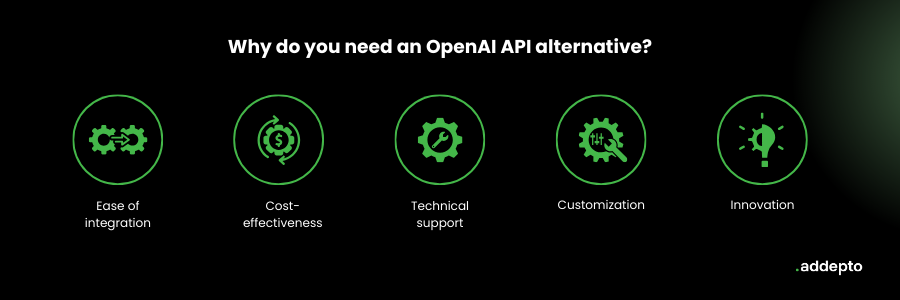
October 13, 2023
OpenAI API Alternatives: Selecting the Right Large Language Model for Your Use Case and Budget
Author:

CSO & Co-Founder
Reading time:
14 minutes
OpenAI has been at the forefront of generative AI systems development for nearly a decade now. The company has created some of the most popular artificial intelligence and generative AI models on the market, with its API giving access to several generative AI models, including GPT-3, GPT-4, and DALL-E.
All these innovations, coupled with market responsiveness to artificial intelligence solutions offered by the OpenAI API, have enabled the company to surpass other AI play providers. In fact, experts predict that OpenAI’s valuations could reach about $80 to $90 billion over the next year. [1] In this post, we will take a look at several generative AI alternatives, and see which is best for your company.
However, evolving market demands have prompted many users to seek other alternatives that offer more specialized, customizable, and cost-effective solutions. If you’re in this predicament, read on as we evaluate some of the best OpenAI API generative AI alternatives and other helpful information to enable you to choose the best one.
What are OpenAI APIs?
OpenAI Application Programming Interfaces (APIs) are a set of tools designed to give developers access to several advanced generative AI models and algorithms that are built and maintained by the company. Essentially, OpenAI APIs act as a bridge between the technology provided by the OpenAI company and the software the software developers create on the platform. [2]
OpenAI provides different types of APIs, each suited to specific functions. Some of the most popular APIs on the platform include natural language processing (NLP) APIs, predictive analytics APIs, image recognition APIs, and NLP APIs. Each of these APIs comes with its own set of unique capabilities that can be used for a variety of uses, particularly around integrating AI into custom software development projects.
Unlock unlimited LLM’s possibilities with Generative AI development company. Reach out to us and transform your business with cutting-edge technology.
Limitations of OpenAI APIs
Despite the many advantages of OpenAI APIs, as all generative AI tools, they come with their own set of limitations. Some of these limitations may affect the functionality and performance of custom software built using the APIs. The most notable limitations of using OpenAI APIs for software development include:
Technical limitations
The technical limitations of OpenAI APIs fall under three categories: latency, processing capacity, and data security. The former is most notably experienced with image recognition and predictive analytics APIs, which may experience delays or lag in processing responses. This may have a negative effect on the overall performance of custom software applications.
Similarly, like with most APIs, OpenAI APIs are limited to the specific amount of data they can process within a specific timeframe. This not only impacts the time it takes to create custom software but may also affect the accuracy of the software.
There’s also been growing concern over the privacy and security of data processed on OpenAI APIs. That’s because there’s limited information regarding what the company does with collected data, leaving some developers skeptical about the safety of their proprietary data.
Functional limitations
OpenAI APIs don’t always perform optimally. They produce inaccurate results sometimes, which may impact the performance and accuracy of generated software. [3] There’s also the issue of flexibility and scalability. Some APIs may not be scalable enough to meet the requirements of some projects. What’s more concerning is their inability to scale enough to manage more complex artificial intelligence models and extensive datasets.
Operational limitations
OpenAI offers a free trial for most APIs. However, the free trial is only effective in testing the API’s features and capabilities. This means that you have to get on a payment plan to use the API’s effectively. While this may not be an issue for large organizations with sufficient budget allocations for projects, it presents a challenge for smaller businesses and individual developers working with limited funds.
Ethical limitations
There’s been a growing issue about the bias and unfairness in the results produced by some OpenAI APIs. Any bias or unfairness in data incorporated into software may cause the developed software to display the same level of bias, thus affecting the software’s accuracy.
Additionally, OpenAI’s generative AI is not very transparent in how it develops and maintains its APIs. The lack of transparency and accountability demonstrated by the company may affect the API’s dependability and trustworthiness. [4]
Why do you need an OpenAI API alternative?
Choosing the best API goes beyond personal preference – you want an API that delivers. Although OpenAI APIs are effective, for the most part, the limitations they present may make them a less-than-ideal choice. Here are some of the biggest reasons why developers and businesses are seeking OpenAI API alternatives:

Ease of integration
Most businesses have established systems and processes in place. Having to develop new systems and processes when deploying applications would not only be time-consuming but also not feasible for any business that’s constantly deploying new software applications.
That’s why most businesses and developers opt for APIs that offer easy integration into existing systems. While all OpenAI APIs have this feature, it doesn’t always work. On the upside, there are several alternatives for OpenAI API that offer easier integration, eliminating the need for manual intervention and facilitating more streamlined workflows.
Cost-effectiveness
Although OpenAI offers cutting-edge solutions, those solutions come at a steep cost, making it harder for some businesses to shoulder the costs.
That said, some OpenAI API alternatives offer similar solutions at more affordable costs. This makes it easier for businesses to access the benefits of artificial intelligence solutions without breaking the bank. Therefore, by choosing a more cost-effective alternative, businesses can lower production costs, freeing up more financial resources for other business operations.
Technical support
Any business that relies on AI solutions for critical operations needs efficient, 24/7 customer support for fast resolution of technical issues. Unfortunately, OpenAI is not very reliable on this front, which means that businesses may experience some downtime when waiting for the company’s support team to reply and resolve issues.
Some alternatives to OpenAI API offer more comprehensive support and resolve technical issues expediently. This can ensure the smooth running of operations and reduce downtime, which is especially beneficial for businesses that rely on AI for mission-sensitive tasks.
Customization
OpenAI API solutions are designed to meet the needs of diverse business applications. This makes them quite generic and limits their ability to meet specific business requirements. Some alternatives to OpenAI offer a higher degree of specialization and customization, allowing businesses to tailor API solutions to their business requirements.
The result is often more effective and efficient solutions, leading to better overall results. Effective customization is also critical for businesses in niche industries that may have requirements that generic solutions cannot fulfill.
Innovation
The generative AI market is highly competitive, with new players entering the market every other day. The increased competitiveness drives innovation, leading to the development of new and improved solutions.
Businesses that leverage these solutions can take advantage of this by choosing an API alternative that offers the best features and latest technology. Ultimately, any business that takes advantage of these innovations can develop better software solutions, enabling it to stay ahead of the competition and maintain a competitive advantage.
Best OpenAI API alternatives
Here’s a detailed comparison of some of the best alternatives for OpenAI API in terms of customization, cost-effectiveness, and ease of integration:
Hugging Face
Hugging Face has built quite a reputation for itself as one of the leading companies developing machine learning tools for natural language processing applications. The Hugging Face API is best suited for chatbot and voice assistant development. [5]
The generative AI and API platform comes with a wide assortment of pre-trained models that can be used to train various NLP-based software applications on a simple interface. And, like most open-source libraries, Hugging Face API comes with community support and resources that enable you to collaborate with other developers on a project and share machine learning models and datasets. It also supports various languages, including English, Spanish, French, and German.
Google Cloud AI Platform
The Google Cloud AI Platform is an assortment of various AI tools and services that enable developers and organizations to develop and deploy AI models. The comprehensive AI-based platform comes with various pre-trained models and APIs, including development tools for PyTorch. It also seamlessly integrates with other Google Cloud Services for easy deployment. [6]
IBM Watson
IBM Watson is arguably one of the most customizable API platforms on the market. The platform provides various AI and machine learning tools and services specially engineered to help developers and organizations build AI-powered solutions in various domains, including finance, healthcare, and retail. [7]
The platform is also easily scalable and can handle large datasets with ease. And, unlike most open-source APIs, IBM Watson comes with enterprise-grade security and privacy, so you don’t have to worry about data breaches while on the platform.
NVIDIA
NVIDIA is one of the most well-known brands in the tech space. The company specializes in manufacturing Graphics Processing Units (GPUs). NVIDIA GPUs have an incredibly high processing power, making them suitable for a wide range of resource-intensive applications such as artificial intelligence research, development, and data analysis.
Besides manufacturing GPUs, NVIDIA also provides several generative AI libraries and tools, including pre-built models and libraries. The platform supports popular frameworks like TensorFlow and PyTorch and facilitates collaboration through access to various developer communities and forums. [8]
CognitiveScale
CognitiveScale is a business intelligence company that leverages generative AI and machine learning to help businesses make better decisions. The company also provides several pre-built models and APIs for natural language processing and computer vision software development applications.
The AI-based platform comes with various tools that make it easy for developers and organizations to build, customize, and deploy machine learning models. It also offers enterprise-grade security and responsive technical support for resolving issues expediently.
Wit.ai
Wit.ai is a generative AI Facebook affiliate primarily focused on Natural Language Processing. The NLP-focused platform offers a conversational interface that enables developers to create, customize, and deploy various Natural Language Processing models like chatbots and virtual assistants.
It supports various programming languages, including Python, Node.js, and Ruby. It also offers several APIs for easy integration with other systems.
How to select the best OpenAI API Alternative
Here’s a simple three-step guide for choosing an OpenAI API alternative:

Step 1: Assess your needs
What are your needs, and what type of AI solutions do you need for your business? To answer this, you first need to consider what features and functionalities are most important to you. This can include everything from APIs, pre-trained models, support for multiple programming languages, and vital collaboration and sharing features.
Once you understand your needs, you can make an informed decision by selecting an OpenAI alternative that meets your needs.
Step 2: Evaluate the alternatives
Once you understand your needs and requirements, you can evaluate the various alternatives for OpenAI APIs that meet your needs. While you’re at it, it is advisable to use a visual help such as a comparison table or other resources to compare each alternative against your requirements and needs.
You should pay close attention to other crucial factors such as pricing, technical support, and features to determine which alternative best suits your needs and budget.
Step 3: Try it out
One of the best things about open-source APIs is they come with free trials and demos you can use to get familiar with the platform and evaluate their suitability. Therefore, before going all-in on an API provider, you should first take advantage of these free trials and demos to see how the API platform performs and whether it meets your needs and expectations.
Factors to consider when choosing an OpenAI API alternative
Besides the factors briefly mentioned above, you should go into detail when selecting an appropriate alternative to OpenAI APIs. In that regard, here are a few factors to consider when selecting an alternative.
Ease of use
This is one of the most important yet often overlooked aspects when choosing the best API management platform. Ease of use doesn’t just involve how easy it is to get an API up and running. But it also covers other crucial issues, such as how easy it is to utilize in terms of discovery, seeing the value of APIs, learning how to use the APIs, getting relevant code for development, and performing an administrative role when collaborating with other developers. You also have to consider how easy it is to integrate the API into your existing infrastructure.
Scalability
Scalability means the ability to handle high volumes of datasets seamlessly. However, when it comes to API management solutions, scalability also means the platform’s capability to scale across multiple platforms, including on-premises, SaaS, and/or containers. The API management solution should also provide the necessary tools to ensure that the APIs can scale at the appropriate priority, including prioritization, throttling, and routing.
As your business grows, you need to ensure that all systems you’re utilizing, including APIs, can grow with your business. With this in mind, you shouldn’t just consider the maximum capacity your APIs can scale up, but also their flexibility in supporting evolving business and technical needs.
Security
With data security issues on the rise, and malware and cyber-attack issues at an all-time high, security is one of the most important factors to consider when looking for any tech solution. [9] At its most basic, an API management solution should provide strong single-sign-on (SSO capabilities and integrate into existing identity and access management (IAM) systems.
The ideal alternative for OpenAI API should also have policies in place to:
- Protect against web-based threats
- Disable login if the VPN isn’t on
- Mandate SSL
- Protect against OWASP Top Ten vulnerabilities
Breadth
How comprehensive is the API management solution alternative for OpenAI API? Does it just facilitate API management, or does it go a step further by covering the full cycle of API management, including developer and deployment functionalities and capabilities?
For the API publishing/developer options, the ideal alternative for OpenAI API should enable you to design, create, test, secure, and manage software application solutions. Similarly, the alternative should enable anyone performing a consumer role to discover, develop, consume (deploy) and monitor software application solutions.
Final thoughts
Large language models like GPT-3 and DALL.E available through the OpenAI API have completely revolutionized how developers design, deploy, and manage generative AI-based software solutions. However, with growing concerns over the non-responsiveness and constant downtimes of the OpenAI platform, developers are now seeking other alternatives.
Some of the alternatives described above offer access to large language models with similar, if not more specialized, features of OpenAI APIs. However, before choosing a specific alternative, you should first consider whether its features and capabilities align with your needs, requirements, and preferences.
We invite you to read our blog in order to find out more about generative AI.
References
[1] Barrons.com. A $90 Billion Valuation for OpenAI? Tech’s New Star Is Hotter Than Nvidia. URL: https://bit.ly/48JNYlY. Accessed October 6, 2023
[2] Openai.com. OpenAI API. URL: https://openai.com/blog/openai-api. Accessed October 6, 2023
[3] Community.openai.com. Getting Inconsistent Results With Same Prompts. URL: https://community.openai.com/t/getting-inconsistent-results-with-same-prompts/14353. Accessed October 6, 2023
[4] Essentia.com. Navigating the Legal Waters: Analyzing the Consequences of Using OpenAI for Personal or Business Documents. URL: https://bit.ly/3PRWBSM. Accessed October 6, 2023
[5] Huggingface.co. URL: https://huggingface.co. Accessed October 7, 2023
[6] Cloud. Google.com. URL: https://console.cloud.google.com/marketplace/product/google/ml.googleapis.com?pli=1. Accessed October 7, 2023
[7] Ibm.com. URL: https://developer.ibm.com/components/watson-apis/. Accessed October 7, 2023
[8] Nvidia.com. Nvidia API. URL: https://developer.nvidia.com/rtx/path-tracing/nvapi/get-started. Accessed October 7, 2023
[9] Sciencedirect.com. A comprehensive review study of cyber-attacks and cyber security; Emerging trends and recent developments. URL:
https://www.sciencedirect.com/science/article/pii/S2352484721007289. Accessed October 7, 2023
Category:





